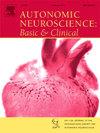Symmetric projection attractor reconstruction: Transcutaneous auricular vagus nerve stimulation for visually induced motion sickness
IF 3.3
4区 医学
Q2 NEUROSCIENCES
引用次数: 0
Abstract
Motion sickness is an enigma that has plagued humans for millennia – and could be exacerbated by automated vehicles and virtual reality. Here, we examined the neuromodulatory effects of transcutaneous auricular vagus nerve stimulation (taVNS) – a non-invasive brain stimulation tool – on autonomic function in response to motion sickness-induced nausea. We conducted a crossover randomized controlled study of healthy participants (n = 29) administered with active taVNS and sham, concurrent with visually-induced motion sickness during electrocardiogram (ECG) acquisition. Using symmetric projection attractor reconstruction (SPAR), a recent mathematical tool that computes images (“attractors”) of morphology and variability of any approximately periodic signals, we show that taVNS induces a significant reduction in measures derived from these attractor image data, compared to sham. Notably, we found that a taVNS-evoked decrease in peak theta density showed a marked correlation with improvements in motion-induced nausea symptom severity. Furthermore, the use of machine learning revealed differential discriminatory power of taVNS response with an area under the receiver operating characteristic curve (AUC) of 0.81. Taken together, these findings provide novel insights into taVNS for motion-induced nausea; and additionally suggest that ECG SPAR-based features may be important for evaluating taVNS therapy response — with implications for adaptive taVNS.
对称投影吸引器重建:经皮耳迷走神经刺激治疗视觉晕车
晕动病是一个困扰人类数千年的谜,而自动驾驶汽车和虚拟现实可能会加剧晕动病。在这里,我们研究了经皮耳迷走神经刺激(taVNS) -一种非侵入性脑刺激工具-对运动病引起的恶心反应中的自主神经功能的神经调节作用。我们进行了一项交叉随机对照研究,29名健康参与者(n = 29)在心电图(ECG)获取期间接受主动taVNS和假药治疗,同时伴有视觉诱发的晕动病。使用对称投影吸引子重建(SPAR),一个最近的数学工具,计算任何近似周期信号的形态学和可变性的图像(“吸引子”),我们表明,与假相比,taVNS诱导了从这些吸引子图像数据中得出的测量的显着减少。值得注意的是,我们发现tavns诱发的θ波峰密度下降与运动引起的恶心症状严重程度的改善有显著的相关性。此外,机器学习的使用揭示了taVNS响应的差分判别能力,其接受者工作特征曲线(AUC)下的面积为0.81。综上所述,这些发现为taVNS治疗运动引起的恶心提供了新的见解;此外,基于ECG spar的特征可能对评估taVNS治疗反应很重要-对适应性taVNS有影响。
本文章由计算机程序翻译,如有差异,请以英文原文为准。
求助全文
约1分钟内获得全文
求助全文
来源期刊
CiteScore
5.80
自引率
7.40%
发文量
83
审稿时长
66 days
期刊介绍:
This is an international journal with broad coverage of all aspects of the autonomic nervous system in man and animals. The main areas of interest include the innervation of blood vessels and viscera, autonomic ganglia, efferent and afferent autonomic pathways, and autonomic nuclei and pathways in the central nervous system.
The Editors will consider papers that deal with any aspect of the autonomic nervous system, including structure, physiology, pharmacology, biochemistry, development, evolution, ageing, behavioural aspects, integrative role and influence on emotional and physical states of the body. Interdisciplinary studies will be encouraged. Studies dealing with human pathology will be also welcome.

 求助内容:
求助内容: 应助结果提醒方式:
应助结果提醒方式:


